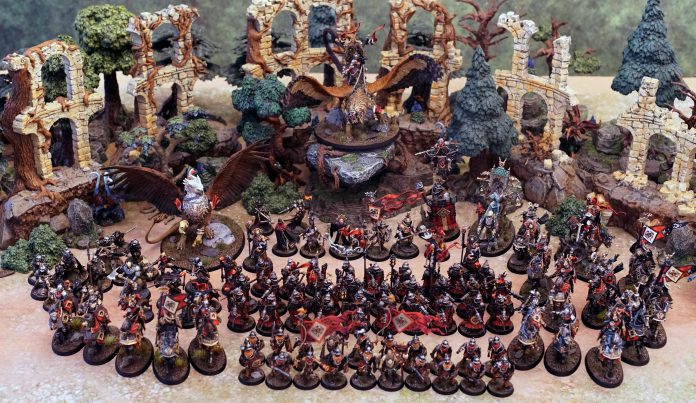Hello all, I’m Connor Tolbert; I’m a member of the Georgia Warband club and I’d like to thank Goonhammer for the opportunity to showcase my army and provide personal insight into my favorite aspect of the wargaming hobby. I first picked up a paintbrush in March of 2021 when I was planning my first D&D campaign, saw the prices of Wizard of the Coast’s miniatures and the fact they came in blind boxes, and then immediately bought a cheap 3D printer and a starter set of paints. Now, three years on, four hobbies deeper, seven armies later, and countless paints cluttering my closet shelf, I’ve realized this isn’t a hobby where you save money, you merely mitigate your losses; and I wouldn’t trade it for anything. So, as we sit in the afterglow of third edition and eagerly anticipate the coming of fourth, I thought it would be a good time to talk about one of the few omni-present pieces of this hobby: the painting phase.
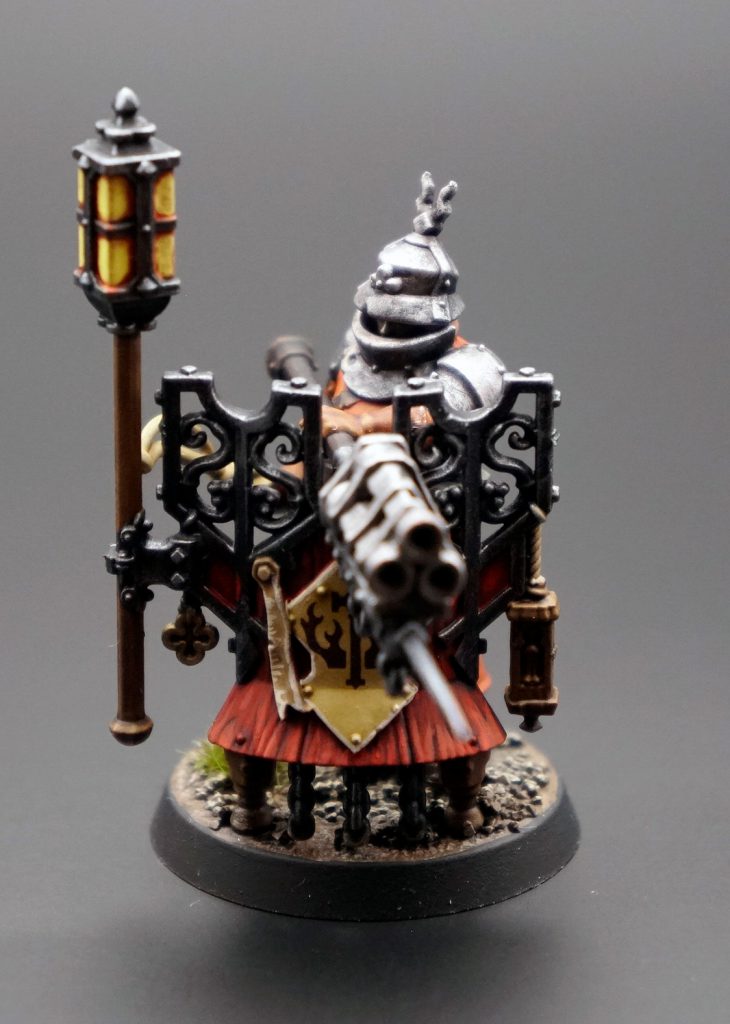
The Method
Before we pick up the paintbrush to start this journey, there are a few philosophical notes I would like to dive into. So, if you’d bear with me for about nine hundred words, I believe this is the axel upon which my painting style revolves.
I’ve always been the obsessive type. When I set out to learn a new skill or pick up a new hobby I tend to dive in headfirst, heedless of the depths into which I am plunging. I watched nearly 20 hours of YouTube tutorials before putting any paint to plastic and my first painting project for the DnD campaign I mentioned earlier consisted of 74 models; a job I completed in 10 days. I would whole-heartedly not recommend this to anyone looking to step into the world of painting. The paint jobs were rough, lines were crooked, eyes – googly. But at the end of that project, I was amazed that I could paint semi-competently and the progression from the first model to the last filled me with satisfaction and the drive to see how much better I could get. My main takeaways from this experiment were: 1) YouTube is a great tool to see new things, but practice is where you learn them. 2) Persistence and consistency are key and 3) Patience is rewarded. Let’s dive into these topics just a bit.
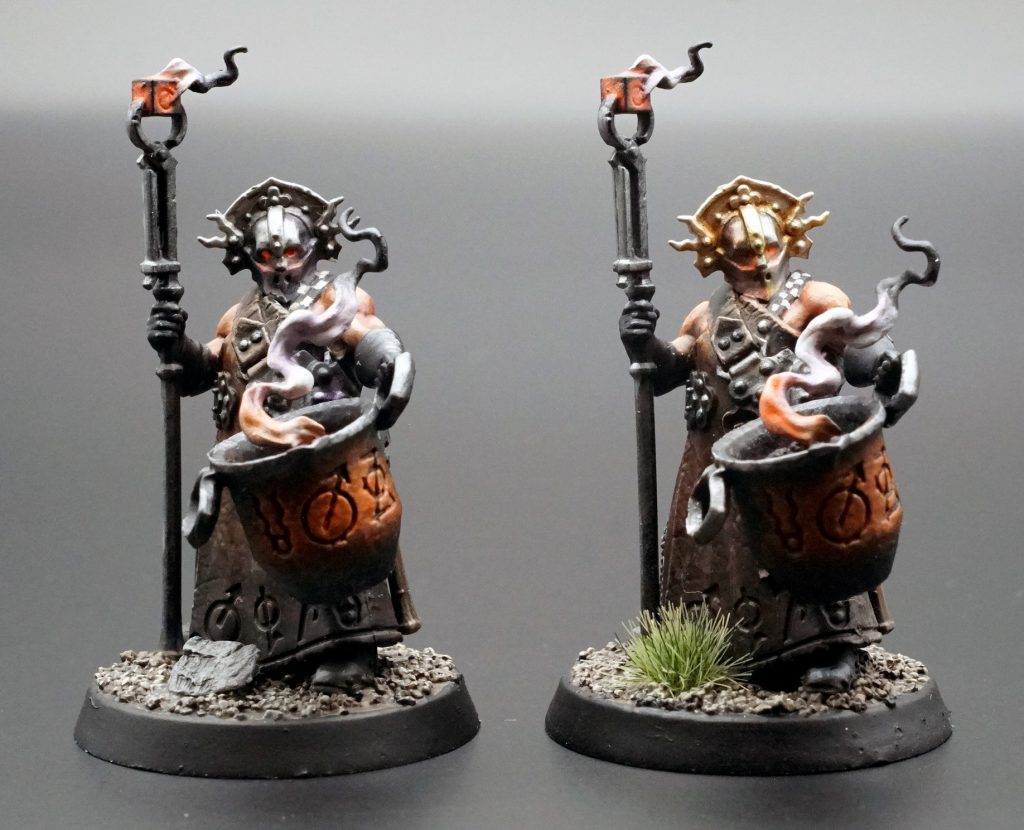
The Modern-day Textbook
YouTube is a fantastic resource, both as an entertainment engine as well as being the largest online resource for learning nearly any skill you could wish. It’s no surprise that many DIY and hobby channels have thrived in the last decade as people who are driven to learn use it as their first port of call. The painting spaces of YouTube are a fantastic resource, and I would strongly recommend everyone to ask themselves a painting question they don’t know the answer to such as “how do I highlight a cloak?” and then find the answer on YouTube. Real groundbreaking stuff here. This should bring up the best painting channels on the site, but I’ll list my favorites here for posterity’s sake: Vince Venturella, Ninjon, Warhipster, and Dr Faust’s Painting Clinic.

Once you’ve found the technique you’re curious about, apply it immediately. While it is great to “know” something, it’s infinitely better to do something with that knowledge. This is where the learning process truly begins and the tricks you learn honing one skill will apply further down the line and the practice you build up early on will pay in orders of magnitude months into the hobby.
Persistence and Consistency
The next biggest piece of advice I give to anyone who asks is this: paint on a schedule. I know, schedules are synonymous with “boring” and “burdensome” but hear me out. I’m not saying you have to paint every day but, if you can, you should. Whether it’s 30 minutes in the evening after you’ve put the kids to bed or an hour in the morning before you start your day if you’re one of those people. If you can only find time to paint on the weekends, then paint every weekend. Just find the time and spend it painting. Last year I painted seven armies, around 30,000 points for Age of Sigmar; and it wasn’t because I’m a fast painter – it’s because I spent about an hour or two every night painting something. Of course this leads back to my own obsessive nature; however, this has been the biggest factor in my own improvement and the people I’ve convinced to try it have remarked how quickly their own armies come together and how less taxing the process feels over trying to bang it out the weekend before a tournament.
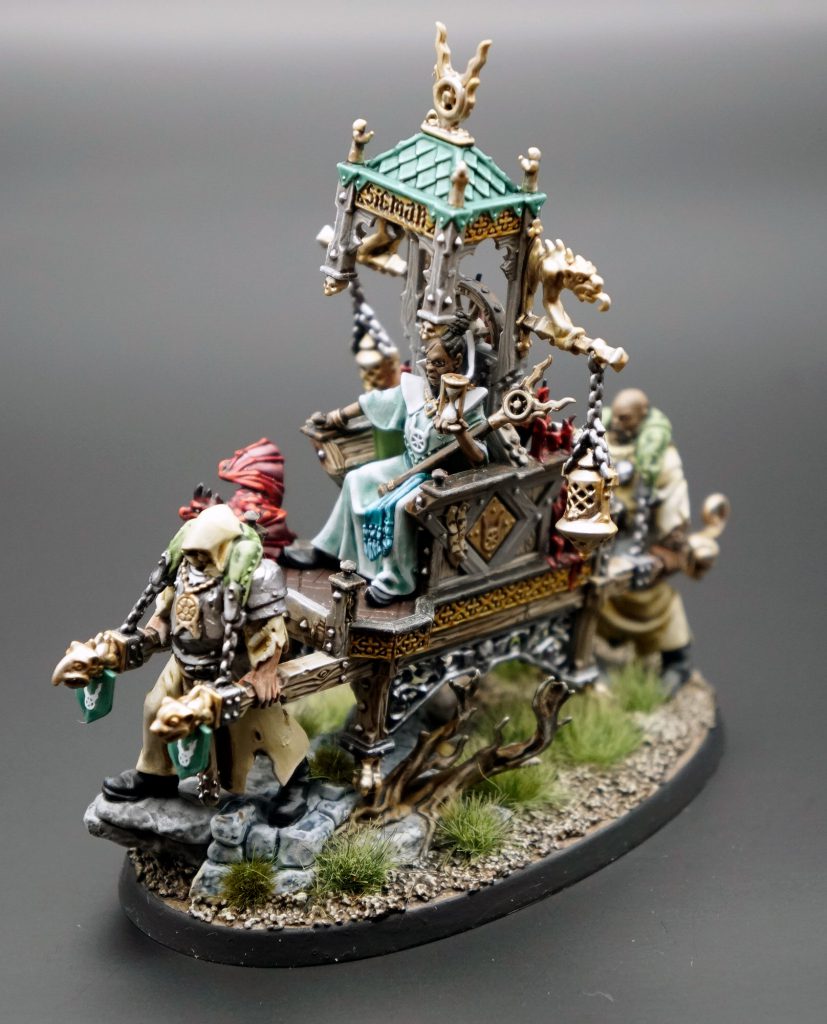
Patience
Patience is the key to a clean paint job. Whenever I try to rush a paint job I end up ripping up undried paint layers, getting paint on parts I did not intend, and the process to fix these mistakes inevitably leads to more frustration and ultimately more time spent painting the model than if I had just taken a breath and done it properly. There are plenty of “quick” painting methods out there that you are more than welcome to try, but the paint jobs I end up liking the most are the old-school layer, wash, highlight; and the forgivingness of this technique leaves me more relaxed throughout the process. Don’t get me wrong, I love contrast paints and incorporate them frequently into my paint jobs, but it is a tool, and tools need to be applied with consideration.
Finishing
The last point I’ll touch on before introducing my army proper, is this: learn where the finish line is. There are always improvements to be done on a model to make it that much better, but if you have forty more Clanrats to finish, Clanrat number seven does not need your care and attention. He doesn’t deserve it. That dude will be eaten by an Infernoth before your opponent even sees the sick freehand you did on his cloak. Spend your painting time wisely. Leave those bits and bobs in shadow and focus on the important pieces. What draws your eye from the table? Look at the model from five feet away, pick out the obvious parts and spend your time there. While painting is a joy in itself, at the end of the day we’re here to play a game and you want to play with these models that you spent all this time working on.
My Cities of Sigmar
With that out of the way let’s see how I utilized these principles for my most recent army: the brand-new Cities of Sigmar. When picking out an army to play I always have a few considerations: 1) Do I like the models? I’m going to be spending over a hundred hours painting and looking at them, so this is of utmost importance. 2) Do I like the theme? And 3) Do I like how they play? It is nice to have a great-looking army but if I dread putting them on the table then it doesn’t matter how good they look- I’ll come to resent them.
When the initial previews of these updated models were being shown I felt like my perfect army had finally been realized. I never liked the empire look of the original cities, and while I admit they have an old school charm, the new range is exactly what I had been waiting to see in this game. The models are exaggerated in just the right way, and the dark fantasy mixed with the Paul Kidby style really resonates with me. If there are two things I love in fantasy it is monsters and normal dudes who have to fight them. This army perfectly encapsulates the latter while their centerpiece, the lovely Tahlia Vedra, give me the opportunity to paint and play the former. I put in my pre-order for the army box and began the planning stage.
The first question I ask myself when starting a new army is: “What is my goal with this army?” Would this be a tightly constructed competitive list, where I would need the ability to swap units out on the whims of GW’s balancing team? Or would this be a display army, one that was brought for best painted, balance be damned? Is it possible to do both? I knew right away that this army would be one that rewarded the effort that is applied to it, and a ten-hour paint job could be noticeably heightened with an extra five. After several practice matches using proxies, I began to get a feel for the army as well as the desire to play it competitively. So my goals are clear: I want to win Best Painted and I want to win an event. Which means only one thing: this is an army that I will be spending a lot of time with, both in painting and playing.
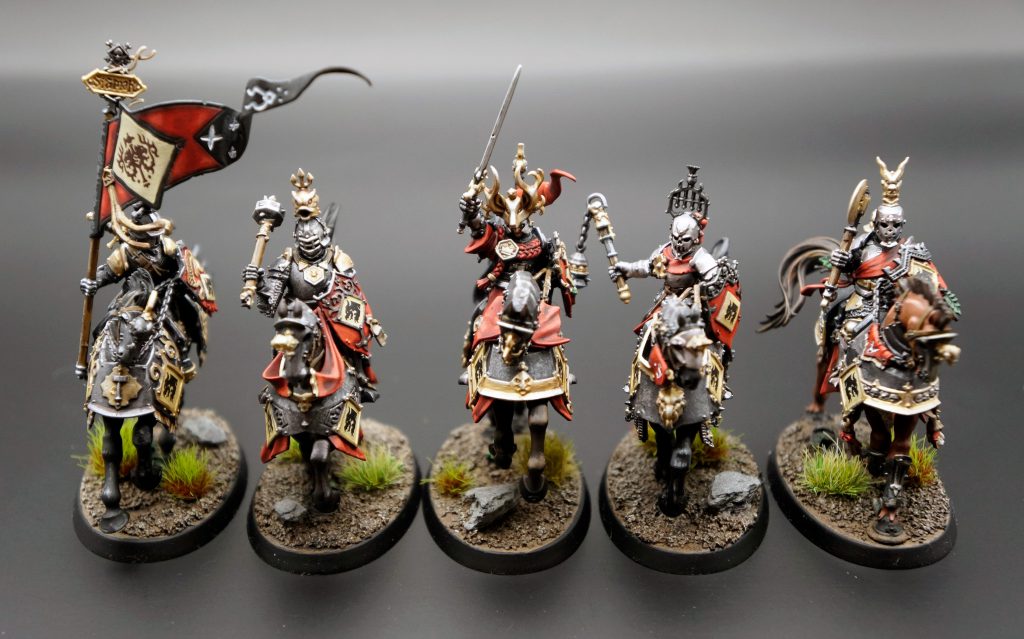
Next, I needed to decide on a scheme. My first idea was that I would paint the models as a unified force of disparate cities that have banded together in a final great defense against the forces of chaos with a rainbow of colors across the battlefield. But as I sketched out the colors and began placing them next to each other in photoshop it never quite felt cohesive, and while a better painter than me could probably have made it work, we can only utilize the skills we have. So I switched gears. By this point my starter box had arrived and with it, a blessed number of extra shields to practice on. I will admit, I’m not great at picking out colors that work well together. I’ve watched videos on color theory as well as videos on how colors accentuate and make models stand out, but it has never quite stuck with me and the few custom schemes I’ve tried have felt muddy and unremarkable. So, I offload that knowledge to someone else, in this case the fabulous painters on the GW paint team.
I picked three paint schemes from the book that stood out to me: Aqshy, Ghyran, and Vindicarum. From there I painted three shields, as I had extras and they were the biggest focus point on this army while on the tabletop. The Ghyran shield felt a little too dark for my personal tastes and it didn’t jump out at me when placed at tabletop level. The Vindicarum shield fared a bit better in this department, but the paints I had on hand required an extra layer each to achieve the desired effect and while for a single model this isn’t a major deal, multiplied over an entire army, this would lead to potentially dozens of extra hours spent. Lastly, I painted Aqshy, and the finished paint job just felt “right”. I felt the red and cream balanced in a nice way and the colors could easily be complemented with my own personal touches down the line without making the paint jobs feel too “busy”.
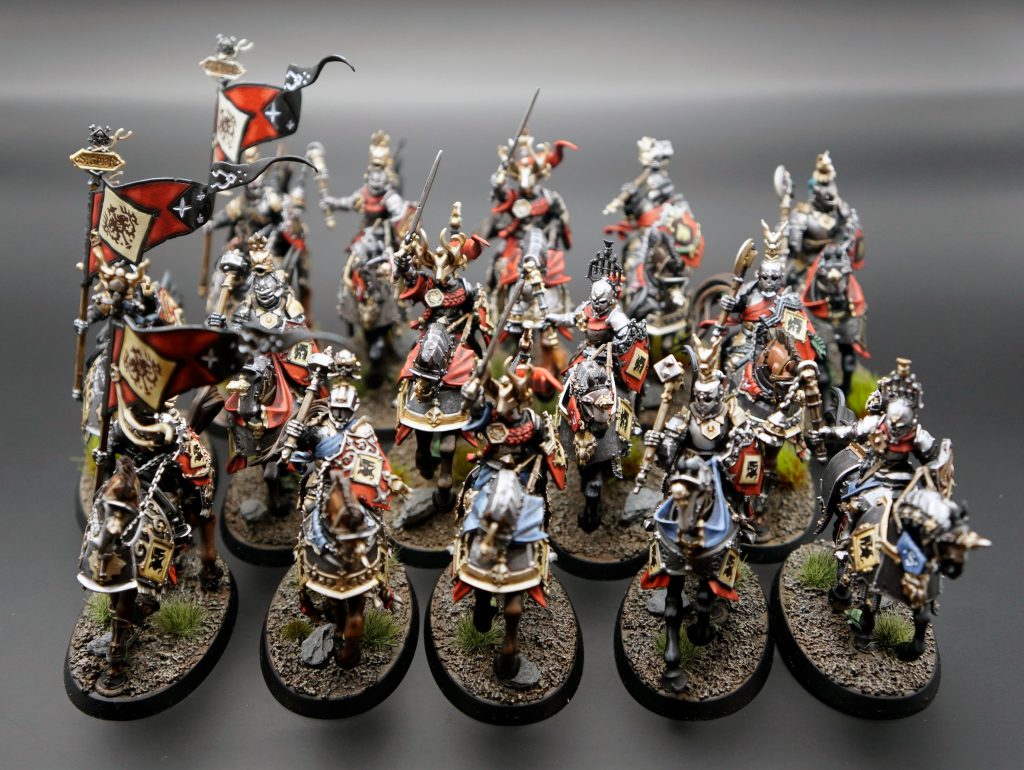
All of this work just to land on the box art colors. It seems the Eavy Metal team know what they’re doing after all. Now I would paint a test model, a humble Steelhelm, as the final test of this scheme. The result pleased me, and I began working on my two units of Steelhelms first. Here I already broke one of my rules: focus on the important parts. I definitely spent too much time on the different leathers and details. I needed two slightly different schemes for each unit of ten to keep the units in order when on the tabletop and, for some unknown reason, I also swapped their leather colors on top of swapping their shirt and waist colors. This led to the paint job taking twice as long as I had planned it to, nearly twenty hours. Oh well. We forge ahead.
A Tangent: Style
After having experimented with dirty looks, pigment powders, mud effects, blood, and gore – I personally really like a clean toy-box style. I’m heavily influenced by the Warcraft universe, and I’ve always found that style very appealing. It is a very different look compared to the popular grim-dark painting style, but both are valid and look amazing side by side on the tabletop. Find an art style that appeals to you and that you find fun to paint and go all in. Over time you’ll find what you like, and it will become more unique as your personality gets expressed through your art.
This process began at the start of the year and as I was finishing these units, the time for sign-ups for this year’s events were beginning. The first big event I could attend this year was the FLG Cherokee 2024 GT and my goal was to have the army ready in time to display there and, hopefully, place for best painted. With a deadline now in place I plotted out how many models I would need to paint weekly to have everything ready in time. With one hitch – GW still hadn’t done their balancing pass yet and it was expected that the next unit on my list to paint, the Freeguild Fusiliers, would see a major nerf. So, I needed to build a replacement list into my schedule in case things went as badly for the fusiliers as what ended up happening. I chose an extra unit of Cavaliers and a Marshal on Griffon to fill in for those points while only adding 6 models to my painting list.
Undaunted I moved on to the units that ended up taking me the longest time to paint – my fusiliers. These are some of my favorite models in the entire game and it is a shame that they have only hit the table in three of my games and disappointed me in every match. Here, I decided the easiest way to paint these would be to glue the shields to the base first and I used white tack to stick the soldiers onto some spare 25mm bases I bought off Amazon. I painted the shields first as that is basically the only thing your opponent will see and spent the time to do it carefully. The men, on the other hand, I sped through quickly and kept the two red and orange colors to help them stand out a bit when all clumped together. I massively pulled back from focusing on the details and spent as little time as I could on the pieces that would be behind the shields. From there I placed my basing material on the shield bases, something I should’ve done before gluing the shields, and quickly painted it. Lastly the men were glued on and around fifty hours later my fusiliers are done.
Next, I moved onto my Freeguild Cavaliers, and I’ve got to say: these are a joy to paint. I’ve painted several units of cavalry before, namely the Lumineth Dawnriders and Windchargers and hated every minute of it, so I was dreading these. But once these 15 horses were complete, I would just have hero-style models left; so I loaded up “The Blade Itself” audiobook and hunkered down for what I thought would be the true slog of this army. Only it wasn’t a slog. Somehow GW designed a model that looks complicated and very detailed, without the paint jobs requiring insane hours to show that off. It’s black magic for all I know. I put my basing material down first here and then primed black. I was going for a dingy metal look so stippling with a gunmetal color did ninety percent of the work here. From there I made three slightly different schemes, each to go with my planned mounted heroes. One unit for Tahlia, one for my Cavalier-Marshal, and one for my Marshal on Griffon. These took about thirty hours to complete, with extra care spent on the banners – one of the major focal points of these units.
Another Tangent: Motivation
We all hit a point in the painting process where the paint job looks bad, we’re tired, or have trouble finding the mental strength to sit down to paint. My own personal motivator is audiobooks. As an avid reader throughout my life, I find it hard to put a book down once I’ve started. So, I listen to books while I paint and only while I paint. That way if I want to know what happens next, I have to sit down and paint at the same time. This won’t work for everyone, but if you can find a trick like this, it really helps push through the hard periods of the painting process.
With the finish line in sight, I’m finally moving onto my favorite models to paint – the singles. No burnout here as by the time I’m getting bored of one model, it’s finished and I can move onto something completely new. Here I did my two Alchemite Warforgers and my Command Corps. Absolute joys to paint; no notes. I kept to the box art style as I really don’t have the brain capacity to figure out a different scheme at this point and I do want more than just red/cream/black/orange on the battlefield. Overall, I spent maybe 15-20 hours on these units in total.
A Final Tangent: Painting Anxiety
Now we’re moving onto the big boys. The centerpiece hero models that will define the army and, every time I get here, I get nervous. What if I mess it up? Now this is a silly question. It’s paint. I’ve messed up countless times while painting other models. I just paint back over it. But for some reason this question inevitably creeps into my mind while mentally preparing to tackle these models. Don’t let these anxieties stop you. In my experience, every time I’ve had this worry, that model has become one of my favorite pieces and the pride I get looking at it, knowing I conquered a major challenge, is a fantastic reward. If you get this feeling, get excited instead, because it might just be your best work yet.

Now we’re about two weeks out from Cherokee and I have a one-day practice event the coming weekend. The deadline is tight but I’m feeling confident. These are the models that I need to get right and so I need to slow down and really spend the time to make them stand out. I start with Pontifex and hit a snag trying to get the color for the wood just right, but Warhipster is here to save the day and his tutorial really helped here. I spend about twelve hours over two days to finish her up. Next, and the model I had originally planned to paint last, is Tahlia. I just really wanted to paint it, what can I say? I look up how to paint chevrons and tutorials on painting bird wings. I used a video by a small YouTube channel called Nyaras Workshop for painting tips on Infernadine, Tahlia’s manticore mount. An airbrush came in clutch for being able to quickly knock out the two monsters in my army and I highly recommend getting one to anyone who doesn’t already have one. Tahlia takes about twenty hours over three days, the chevrons and freehand on the cloth takes too much time to get just right, but the practice pays off on the final two models. The Cav Marshal is next and having painted fifteen horses and with my practice of the freehand on the banners under my belt I knock him out in about seven hours.
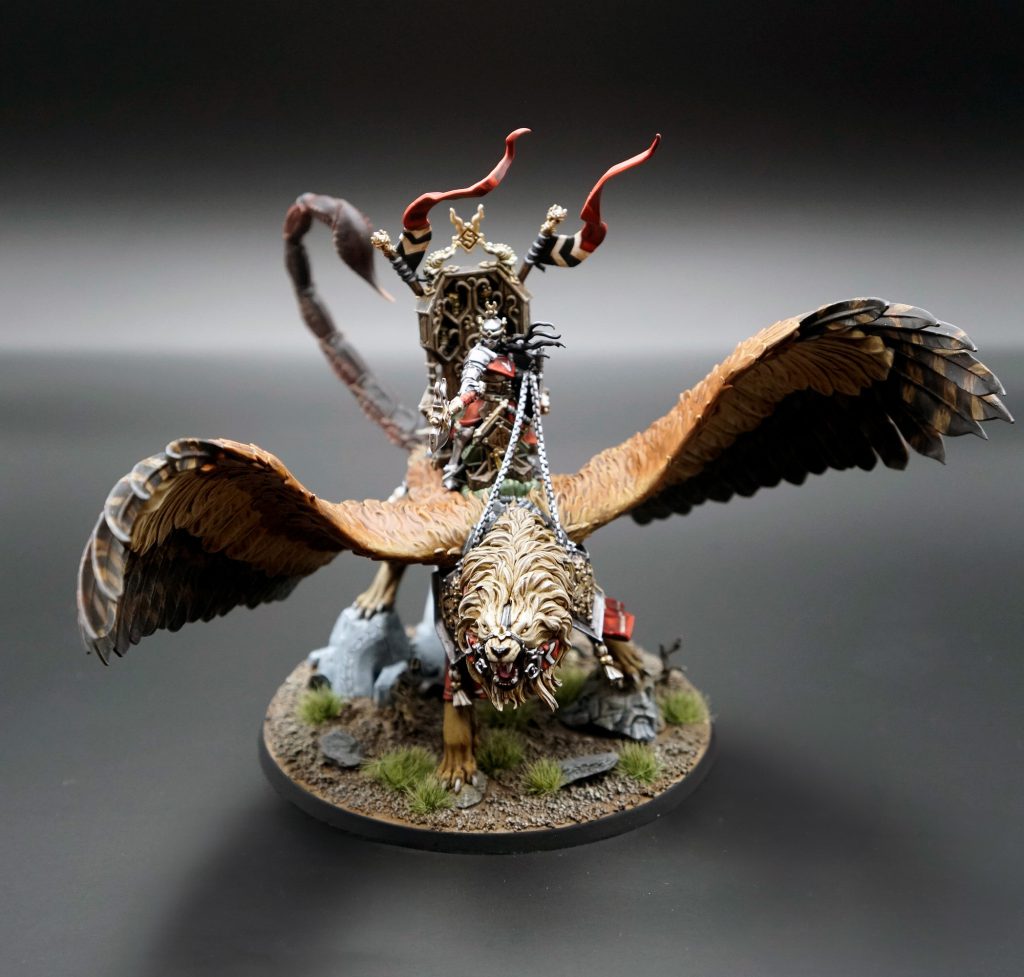
Now I get the chance to play with the army at our practice event for Cherokee. I bring my post-nerf fusiliers and they underperform. So, with that knowledge, I know I need to finish my Marshal on Griffon, a 3D printed model from Titan Forge Miniatures, in order to have a competent list for Cherokee. The painting goes very similarly to Tahlia, but is a bit easier and quicker, I paint him up as a bit of an homage to the World of Warcraft alliance griffon mount and paint the marshal as an homage to the empire-style marshal that graced the cover of the second edition Cities battletome. It takes about fifteen hours over two days.
I quickly build a display board using Dwarven Forge pieces that I painted up years ago for D&D. I get everything magnetized and packed up for transport. My wife and I head out to Harrah’s resort in Cherokee for a long weekend.
The Results
I end up doing fine in the tournament itself, going 3-3, in the process learning a lot about how to properly play the army. But the real reason we are here is the paint judging. I’m told on day two that I’ve been selected as a finalist and to be around for awards. The competition is fierce and there’s some amazing looking armies, so I’m already thrilled just to be recognized. Could I win? The butterflies start to set in on the third day. I have two amazing games as we wait for the tournament to end and the winners to be announced. At the end of it all I end up placing second. Trophy in hand I’m already planning how to augment my army for the next event, Warzone: Level Up Games in April.
I shift my army to focus on the witch hunter units, adding in a unit of Wildercorps Hunters, Hexbane’s Hunters, and the Van Denst duo. I have to sub out Tahlia, to make it work, but I get the “OK” to include her on my display board.
The painting competition at this event is just as strong as Cherokee. A Thunder Lizard army by Reed Herner, who won best painted at my first ever GT last December with a jaw-dropping Dark Crystal themed Tzeentch army. I play much better in this tournament than the last, winning three games and losing a close game to Kevin Lathers but I get decimated by Stuart King in the Cities mirror. Awards time and once again, the butterflies set in. And I win. The truth of it doesn’t really settle in until I get home but I’ve actually achieved one of the two goals I set when I began this army project. The hours huddled over my underlit painting desk and all the cramped hands and strained eyes were worth it. I have an army that I’m proud of and others seem to think it looks nice as well, which is a bonus.
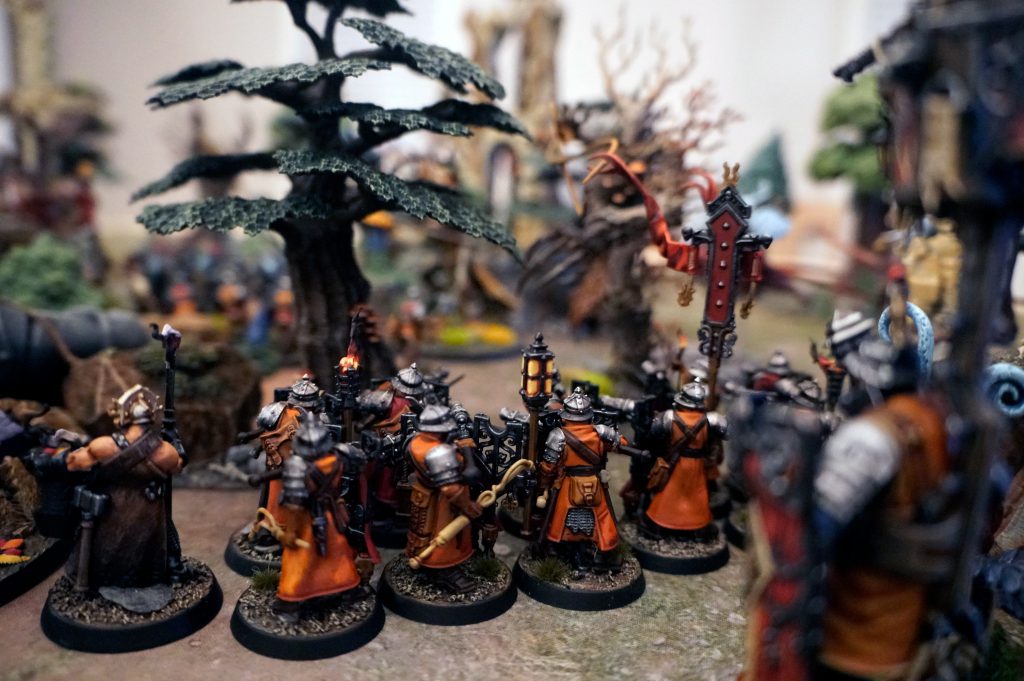
Now I just need to get better at the game.
Final Thoughts
I loved nearly every second painting this army. But would I recommend it to a beginner? Probably not. It is an army that has a high skill floor, but also a high skill ceiling; so, if you really put in the time, it is able to be appreciated from across the table. A really skilled painter can make this army shine. But also, don’t listen to me. Do what makes you happy. I certainly wouldn’t listen to someone on the internet telling me not to paint an army I have my eye on, fuck you buddy I do what I want. Everyone’s painting journey starts somewhere, pick something you like and have fun.
Have any questions or feedback? Drop us a note in the comments below or email us at contact@goonhammer.com.
